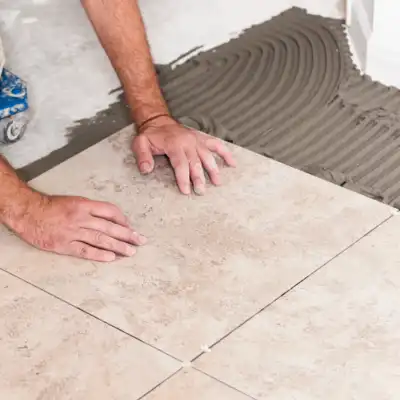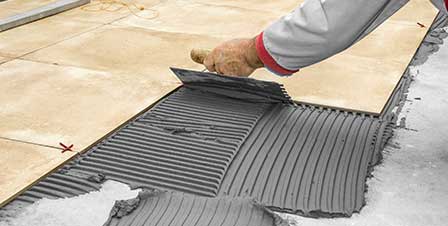Boost Your Residential Property: Specialist Tile Installation Austin Solutions
Boost Your Residential Property: Specialist Tile Installation Austin Solutions
Blog Article
Discover the Secrets to Perfect Ceramic Tile Installment Every Time
Understanding the art of ceramic tile installation involves a series of specific steps and methods that, when performed appropriately, can result in a refined and seamless finish. By comprehending the secrets behind each action, you can guarantee that your ceramic tile setup not only fulfills yet exceeds your expectations.
Correct Surface Prep Work
Effective tile installation hinges considerably on thorough surface preparation to ensure a flawless outcome. Before laying floor tiles, it is critical to evaluate the substratum's problem extensively. The surface needs to be tidy, completely dry, and structurally sound to stop future concerns such as loose floor tiles or fractured cement. Any kind of existing floor covering product, adhesives, or sealers must be eliminated to produce a consistent base for the brand-new floor tiles.
To guarantee correct bond, it is suggested to rough up smooth surface areas with sanding or scarifying. In addition, using a guide can improve bonding in between the substrate and the ceramic tile adhesive. Unequal surface areas should be leveled using a self-leveling compound to prevent lippage and make sure a smooth coating.
In addition, looking for possible resources of moisture is essential, as excess moisture can cause mold growth and damage the ceramic tiles in time. Making use of a dampness barrier or waterproofing membrane layer in damp locations like kitchens or shower rooms is necessary to protect the tiles from water damage. By thoroughly preparing the surface area prior to tile setup, one can produce a visually attractive and long lasting tiled area that will stand the test of time.

Choosing the Right Adhesive
Selecting the suitable adhesive is a critical step in making sure the successful setup of ceramic tiles. The type of sticky you choose will depend on various factors such as the kind of ceramic tile, the substratum product, and the location of the installation. There are various kinds of adhesives offered on the market, consisting of thin-set mortar, mastic, and epoxy.

Epoxy adhesives are very sturdy and waterproof, making them suitable for areas prone to moisture such as kitchen areas or restrooms. They are likewise suitable for installing glass or metal tiles. When selecting a glue, ensure to comply with the manufacturer's suggestions and take into consideration the certain needs of your tile installment task.
Precision Cutting Techniques
One of the most typical tools utilized for precision cutting in floor tile setup is the ceramic tile read this article cutter. Ceramic tile cutters come in numerous types, consisting of hands-on floor tile cutters, electrical damp saws, and handheld ceramic tile cutters. Hand-operated floor tile cutters are suitable for straight cuts on ceramic and porcelain tiles, providing clean and accurate edges.
Furthermore, utilizing devices like tile scribes or glass cutters can aid in scoring and breaking ceramic tiles with precision. By mastering these precision reducing methods, ceramic tile installers can make sure a specialist coating and an aesthetically appealing outcome in their tile tasks.

Grout Application Tips
When transitioning from precision cutting strategies to grout application in floor tile installation, interest to information and technique is extremely important for accomplishing a flawless coating. Cement serves not only as a useful component that fills the spaces in between ceramic tiles yet additionally plays a considerable duty in the general aesthetic of the installment.
Once the cement is applied, make use of a wet sponge to clean up the tiles, making certain not to eliminate cement from the joints. Adhering to these grout application suggestions will result in a properly mounted floor tile surface that enhances the appeal of any type of room.
Finishing Touches and Upkeep
To complete the tile installment task efficiently, focus to detail original site during the ending up touches and routine maintenance is critical. After the grout has dried out and the ceramic tiles are firmly in place, the last actions entail making sure that all edges are appropriately sealed.
Regular upkeep is crucial to preserving the elegance and capability of your tiled surface areas. A straightforward routine of sweeping or vacuuming followed by mopping with a mild cleaner can help maintain your tiles looking immaculate (tile installation austin). For locations that are often exposed to dampness, such as kitchens or shower rooms, routine resealing of cement lines is recommended to stop mold and mildew development
Final Thought
Finally, accomplishing ideal tile setup every time needs focus to information and appropriate techniques. By concentrating on surface area prep work, picking the correct adhesive, utilizing accuracy reducing approaches, applying grout carefully, and completed with attention to information, you can guarantee a professional-looking result. Bear in mind to follow these steps and keep your floor tiles frequently to prolong their life-span and keep them looking their ideal.
One of the most usual tools utilized for accuracy cutting in ceramic tile setup is the tile cutter. Floor tile cutters come in various kinds, consisting of manual floor tile cutters, electric damp saws, and handheld ceramic tile cutters. Hand-operated floor tile cutters are ideal for straight cuts on ceramic and porcelain ceramic tiles, providing precise and tidy edges. Furthermore, making use of devices like ceramic tile scribes or glass cutters can assist in racking up and address snapping floor tiles with accuracy. By mastering these precision cutting strategies, floor tile installers can make sure a specialist finish and a visually attractive result in their floor tile jobs.
Report this page